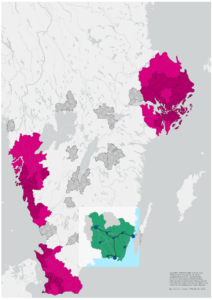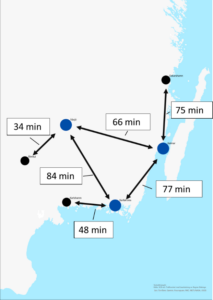The Southeastern Triangle – a territorial strategy for regional exchange
The Regions of Blekinge, Kalmar and Kronoberg, together with the Cities of Kalmar, Karlskrona and Växjö, are exploring opportunities for international exchange and comparisons with other cities and regions as part of their territorial strategy, the Southeastern Triangle.
Background and structure of the regional exchange

The Southeastern Triangle is a territorial strategy for sustainable urban development in Southeastern Sweden. The strategy has been developed and is jointly owned by the Regions of Blekinge, Kalmar and Kronoberg, and the Cities of Kalmar, Karlskrona and Växjö. Located in Southeastern Sweden, this geographic area connects the three regions, including their regional capitals, nine municipalities and two universities. The Southeastern Triangle connects three labour market regions with a total population of approximately 380,000.
To address the challenges faced by small and medium-sized cities and regions in competing for investments, attracting residents, and building skills, the need for an interregional territorial strategy became clear. The region’s industries, including those in green transition and security, are growing but struggle to attract talent. Adding to this, administrative and mental boundaries pose obstacles to attractiveness and development. It was with this background the Southeastern Triangle was developed.
For the regions to best contribute to the green and digital transition, they need to become more attractive as places to invest and live in. In addition, knowledge sharing between actors in the region also needs to increase to better utilize available resources and expertise to reduce climate-impacting emissions. For this to happen, there must be greater exchange between the regions’ three growth engines and their associated local labour market regions. With the Southeastern triangle, cooperation across municipal and regional boundaries can be achieved.

International exchange and comparison
As a part of this strategy the regions and cities want to explore the possibilities of international exchange and comparisons with other cities and regions.
Therefore, the actors within the Southeastern Triangle are looking for possibilities to compare their work with other cities and regions that also have an ambition to strengthen functional integration. Thematically, the Southeastern Triangle is mainly interested in governance structures, for example joint organisation to promote functional connections and communication solutions and active efforts to increase functional integration within culture, higher education, innovation or public ticketing systems. Additionally, cooperation related to innovations, skills supply, and similar developments in the geographic area are interesting thematic areas for different type of knowledge exchanges.
Selection criteria

To be part of the comparison, the actors within the strategy have selected a few criterias for the selection of other cities and regions. The first selection criterium is related to size and distance, it must be at least two-three labour markets regions, in small to medium-sized cities, that have historically been separate and have approximately 60 minutes of commuting distance between their cores. The second criterium points out that the regions should not be part of a metropolitan area’s extended labour market. Moreover, the region should have ambitions to cooperate. Lastly, it is preferred that the region has access to a university or higher education institution.
Interested in international exchange?
Please contact Daniel André, at daniel.andre@regionblekinge.se

